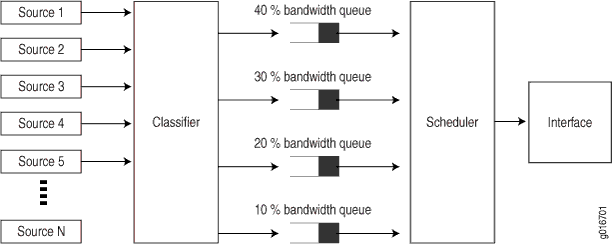Junos OS CoS 프로세스를 통한 기본 패킷 플로우 구성
그림 1 과 그림 2 는 Junos OS CoS 기능의 구성 요소를 보여주며, 이들이 상호 작용하는 시퀀스를 보여줍니다.

 통한 패킷 플로우
통한 패킷 플로우
다음 구성은 CoS 프로세스를 통한 패킷 플로우를 보여줍니다.
분류자 정의
패킷 헤더에서 CoS 값을 신뢰하는 경우 동작 집계 분류를 사용하여 해당 값을 포워딩 클래스에 매핑하고 우선순위를 삭제할 수 있습니다. 예를 들어:
[edit class-of-service]
classifiers {
exp exp_classifier {
forwarding-class data-queue {
loss-priority high code-points 001;
loss-priority low code-points 000;
}
forwarding-class nc-queue {
loss-priority high code-points 111;
loss-priority low code-points 110;
}
forwarding-class video-queue {
loss-priority high code-points 011;
loss-priority low code-points 010;
}
forwarding-class voice-queue {
loss-priority high code-points 101;
loss-priority low code-points 100;
}
}
패킷 헤더에서 CoS 값을 신뢰하지 않는 경우 보다 복잡한 멀티필드 분류를 사용하여 수신 트래픽을 포워딩 클래스로 매핑하고 우선순위를 삭제할 수 있습니다. 예를 들어:
[edit firewall]
family inet {
filter classify {
term sip {
from {
protocol [ udp tcp ];
port 5060;
}
then {
forwarding-class nc-queue;
loss-priority low;
accept;
}
}
}
}
더 보기
인터페이스의 수신 패킷에 분류자 적용
계층 수준에서 논리 인터페이스 [edit class-of-service interfaces] 에 동작 집계 분류자를 적용합니다. 예를 들어:
[edit class-of-service]
interfaces {
so-* {
unit 0 {
classifiers {
exp exp_classifier;
}
}
}
t3-* {
unit 0 {
classifiers {
exp exp_classifier;
}
}
}
}
계층 수준에서 논리 인터페이스 [edit interfaces] 에 입력 필터로 멀티필드 분류자를 적용합니다. 예를 들어:
[edit interfaces]
fe-0/0/2 {
unit 0 {
family inet {
filter {
input classify;
}
address 10.12.0.13/30;
}
}
}
트래픽을 제한하고 혼잡을 제어하는 폴리서 정의
트래픽 플로우를 속도 제한해야 하는 경우 과도한 트래픽(하드 폴리싱)을 폐기하거나 초과 트래픽을 다른 포워딩 클래스 및/또는 손실 우선순위(소프트 폴리싱)로 재할당하여 폴리시에를 정의하고 폴리서를 해당 트래픽 플로우에 대한 방화벽 필터에 적용합니다. 예를 들어:
[edit firewall]
policer be-lp {
if-exceeding {
bandwidth-limit 10m;
burst-size-limit 62500;
}
then loss-priority high;
}
family inet {
filter be-lp {
term t1 {
from {
protocol tcp;
port 80;
}
then policer be-lp;
then loss-priority low;
then accept;
}
}
}
더 보기
드롭 프로파일 정의
드롭 프로파일을 사용하여 지연 버퍼 점유 범위에서 드롭 확률을 정의하여 RED(Random Early Detection) 프로세스를 지원합니다.
[edit class-of-service]
drop-profiles {
be-red {
fill-level 20 drop-probability 25;
fill-level 30 drop-probability 50;
fill-level 40 drop-probability 75;
fill-level 50 drop-probability 100;
}
}
더 보기
각 포워딩 클래스를 대기열에 할당
각 포워딩 클래스에 차별화된 서비스를 제공하려면 각 포워딩 클래스를 자체 출력 대기열에 할당합니다. 예를 들어:
[edit class-of-service]
forwarding-classes {
queue 0 data-queue;
queue 1 video-queue;
queue 2 voice-queue;
queue 3 nc-queue;
}
더 보기
스케줄러 정의
각 포워딩 클래스에 대한 스케줄러 특성을 정의합니다. 예를 들어:
[edit class-of-service]
schedulers { #
data-scheduler {
buffer-size percent 50;
drop-profile-map loss-priority high protocol any drop-profile be-red;
priority low;
transmit-rate percent 50;
}
nc-scheduler {
buffer-size percent 5;
priority high;
transmit-rate percent 5;
}
video-scheduler {
buffer-size percent 25;
priority strict-high;
transmit-rate percent 25;
}
voice-scheduler {
buffer-size percent 20;
priority high;
transmit-rate percent 20;
}
}
더 보기
스케줄러 맵 정의
스케줄러 맵을 사용하여 스케줄러를 포워딩 클래스로 매핑합니다. 예를 들어:
[edit class-of-service]
scheduler-maps {
sched1 {
forwarding-class data-queue scheduler data-scheduler;
forwarding-class nc-queue scheduler nc-scheduler;
forwarding-class video-queue scheduler video-scheduler;
forwarding-class voice-queue scheduler voice-scheduler;
}
}
더 보기
CoS 헤더 재작성 규칙 정의
규칙을 다시 작성하여 나가는 패킷의 CoS 비트 패턴을 재정의합니다. 예를 들어:
[edit class-of-service]
rewrite-rules {
inet-precedence inet-rewrite {
forwarding-class data-queue {
loss-priority high code-point 001;
loss-priority low code-point 000;
}
forwarding-class nc-queue {
loss-priority high code-point 111;
loss-priority low code-point 110;
}
forwarding-class video-queue {
loss-priority high code-point 101;
loss-priority low code-point 100;
}
forwarding-class voice-queue {
loss-priority high code-point 011;
loss-priority low code-point 010;
}
}
}
더 보기
송신 인터페이스에 스케줄러 맵 및 규칙 재작성 적용
[edit class-of-service]
interfaces {
ge-* {
scheduler-map sched1;
unit * {
rewrite-rules {
inet-precedence inet-rewrite;
}
}
}
}
